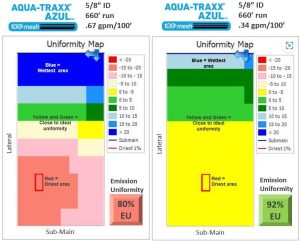Original article by Progressive Farmer (Dan Crummet)
Roger Johnson and his family have farmed an 80-acre plot just outside the western city limits of Hoxie, Kan., for years under flood irrigation. Even while using all of the 800 gallons per minute available, it was necessary to split the 80-acre piece in two and farm different crops to manage the water.
“We always had problems getting water through the field,” Johnson explains, “and many times the crop we produced would be very good on one end of the field and nonexistent at the other. I remember before we installed subsurface drip irrigation (SDI) on the field, one year we made 165 bushels of corn there.”
In 2012, a very dry year even in country that expects only 15 to 18 inches of rainfall annually, Johnson and his brother, Bob, and son, Heath, binned 220 bushels per acre on the 80-acre field by applying water at a 600-gallonper- minute rate—75% of the well’s capacity—with subsurface drip irrigation. This past year, that same field produced a 79-bushel soybean crop.
FLOOD DIDN’T WORK
Since 2007, the Johnsons have moved a quarter of their 1,300-acre operation into SDI. Meanwhile, another quarter of their no-till operation is watered under center pivots. The remainder is dryland.
“Flood irrigation just wasn’t working for us. We Were using all of our water and still couldn’t depend on producing a full crop,” Johnson recalls. “And, because we have a power line easement and poles running through the middle of much of our farm, it would take two center pivots on each side of the high lines, and that would be inefficient because we’d have to ‘windshield wipe’ them— plus they leave unwatered corners.”
That explains the Johnsons’ early interest and adoption of SDI as a means to greater efficiency and reduced labor.
“We’re still pumping about the same amount of water,” Johnson explains, “but we know when we plant something, unless something happens to it, we’re going to have a crop to harvest. That wasn’t the case with the flood system. Crop consistency can go a long way to making your operation much more profitable,” he adds.
Working with Multi-States/Western Irrigation from Garden City, Kan., the Johnsons became the first in their area of northwest Kansas to bury drip tape, paying $1,500 per acre to boost their water efficiency.In the years since, Johnson says another half-dozen SDI installations have been made in the Sheridan County area.
GOOD ECONOMIC MOVE
“Yes, it’s expensive up front,” Johnson explains, “but to be able to consistently produce crops across an entire field, despite the heat and drought, helped us remain economically viable.” The crop consistency, reduced labor and maintenance, and improved water efficiency add up to a conservative payout estimate of about seven to 10 years, Johnson says.
Today, the Johnsons have about 340 acres under SDI divided into 6- to 12-acre zones. The drip tape is buried 15 inches deep and is installed on 60-inch centers with the crop planted on 30-inch rows—two rows between tape runs. A precision-guidance system keeps planting on track between the buried tape, and strip-till tools allow for precise placement of half the season’s required fertilizer in the fall. (The remainder is run through the SDI system as a 32% N liquid supplement as the crop develops.)
“RTK makes all this possible,” Johnson says, noting he plants an inch outside the previous year’s crop and then the following year plants an inch on the other side of the first crop to ensure crop residues don’t get in the way of good seed placement in the farm’s rotation scheme.The Johnsons grow corn, grain sorghum, soybeans, wheat and sunflowers.Maintenance consists of repairing rodent damage to the buried tape (twice during last year’s growing season and maybe a dozen spots a year on more than 300 acres) and chlorinating the system at the end of the growing season.Then, in the spring, the systems have to be flushed. Sand filters on each well protect the drip tape from plugging.
BETTER THAN FLOOD
Johnson says he’s not interested in arguing “which is best” between center pivots and SDI, saying they both are great improvements over flood irrigation. “However, that said,” he notes, “I’ve never had an SDI system blown down by wind or crushed in an ice storm. My SDI has never had a flat tire or a stripped gear box. And, the SDI requires less maintenance and costs less to insure,” he chuckles, eyeing an 80 across the road from his home that once was under flood irrigation.“I’m looking forward to getting it in SDI, but when we do it, we’ll make big changes in our rotation scheme
YOU NEED AN SDI DESIGNER
Hoxie, Kan., no-tiller Roger Johnson says there’s a lot more to installing a subsurface drip irrigation system than plowing in the tape. He credits Randy Wildeman, sales engineer at MultiStates/ Western Irrigation, in Garden City, Kan., for the good design on all of his drip zones.
We asked Wildeman for a checklist of things you need to explore before pulling the trigger on an SDI system.
Survey each field to create a map, and take into consideration elevation differences, how much flow you’ll need to uniformly water each zone and what size drip tape and emitter spacing will be required.
Water samples will need to be analyzed for quality and fiow capacities, and soil types will need to be considered to determine lateral and emitter spacings.
The shape of the fields will guide the products used and the length of runs installed.
“You may need to break a larger field into smaller zone blocks to reduce the size of pipes and filters that will be needed to water a given zone at any given time. This can help save money on the overall installation,” Wildeman says, adding that he sees growing demand for SDI in the High Plains.
“ It has a lot to do with water restrictions and the drop in the Water table of the Ogallala Aquifer.” Thirty to 40% of his firm’s business is converting center-pivot farms to SDI.
“Of course, converting from flood to SDI is the most common and shows the most bang for the buck. But a lot of producers are taking down their sprinklers and swapping it for drip tape,” Wildeman says
HOW TO EXPLORE SDI
Roger Johnson says producers interested in SDI should spend a lot of time talking with people who use it.
“Visit with them, visit their operations and spend a lot of time on the Internet learning about how SDI works in areas similar to yours,” he suggests.
There are several good websites devoted to SDI, and many of those have lists of frequently asked questions.
One Johnson likes is www.ksre.k-state.edu/irrigate/ OOW/P06/Lamm06S17.pdf.
“It’s based on conditions very similar to those on my farm,” he explains. “But even for those in other states, the basic information at this site can answer a lot of questions.”
Click here for more information on subsurface drip irrigation.




